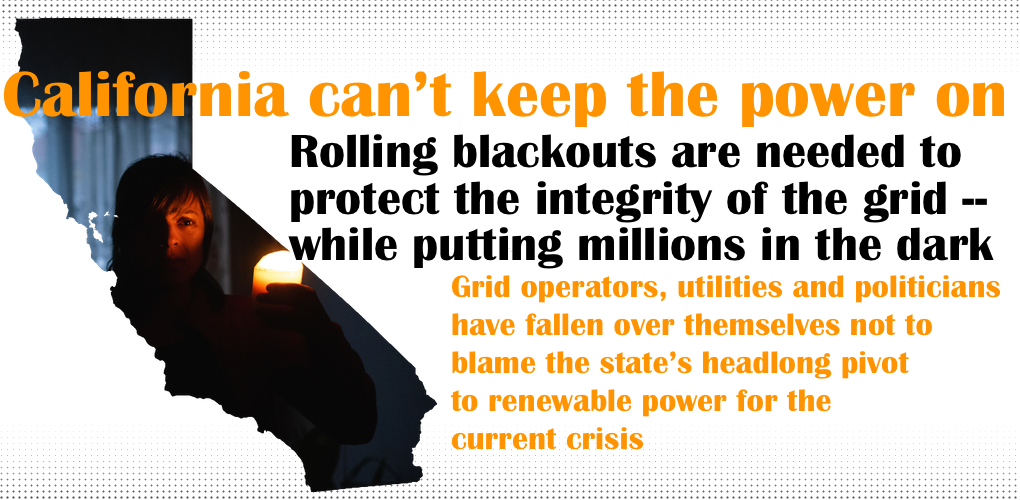
When Warnings Become Blackouts
This was not part of the plan. In fact, some might wonder if there was a plan. In the midst of a heatwave, California can’t keep the power on. To ensure the grid for the entire Western U.S. doesn’t collapse, California’s grid operator has been forced to cutoff power for millions of people for hours at a time.
As the crisis unfolds, there’s no shortage of finger pointing and hand wringing colored with talk of a perfect storm of circumstances, but California’s predicament was hardly unforeseen nor is it particularly exceptional. Rather, it was utterly predictable, and it surely should be a warning for every grid operator, policymaker and utility across the country chasing the green dream.
As E&E News reported, Steve Berberich, CEO and president of the California ISO, said regulators knew the power shortfall was coming and failed to act. “The situation we are in could have been avoided,” Berberich said. “For many years we have pointed out to the procurement authorizing authorities that there was inadequate power available” during the evening hours after sunset when solar energy stops producing. He further explained that in “filing after filing after filing,” California ISO warned that the system that determined how much power was needed to ensure reliability “was broken and needed to be fixed.”
While grid operators, utilities and politicians have fallen over themselves not to blame the state’s headlong pivot to renewable power for the current crisis, the challenges of managing the intermittency of renewable sources of power is the elephant in the room. Not only is solar power of little use when demand peaks late in the day when air conditioners are running full blast and the sun begins to set but a contributing factor to this crisis was that 1,000 MW of wind capacity – enough to power several hundred thousand homes – was unavailable when needed. In other words, there was no wind.
The shift away from dispatchable power, happening across the country, is undermining the reliability and resilience of the grid. As Frank Wolak, a Stanford University economics professor who specializes in energy markets, told The Mercury News, “We have a much more risky supply of energy now because the sun doesn’t always shine when we want and the wind doesn’t always blow when we want. We need more tools to manage that risk. We need more insurance against the supply shortfalls.”
Wherever wind and solar have come to produce a sizeable share of a grid’s power – in California it’s now about 33 percent – reliability challenges have followed. Wade Schauer, Americas power and renewables research director at Wood Mackenzie, explained to Bloomberg, “You can’t control the solar and wind. When it’s gone, it’s gone.”
Whether California, Texas or Germany, the story sounds troublingly familiar. The challenges of the shift to renewables are dismissed by solar and wind boosters only to slam consumers. Higher costs and less reliable power aren’t a bug of the pivot to intermittent energy, they’re a feature. Certainly, the challenges can be managed and mitigated but they’re real and the costs are falling on families that can’t afford them and shouldn’t have to shoulder them.
Across the country – in California, Texas and New England – grid operators are warning about design flaws in electricity markets that don’t properly value dispatchable generation or fuel security. Reserve margins of generating capacity have become razor thin in some markets, and in others overreliance on just-in-time fuel delivery and overtaxed transmission networks have introduced new dimensions of risk that simply did not exist just a few years ago.
The message for those listening is to exercise well-founded caution and reassess the value of existing resources. If markets aren’t properly valuing the balance, reliability and fuel security offered by baseload power plants, particularly coal plants, isn’t it time to ensure they do?
While the evidence continues to mount that the costs and challenges posed by the race to renewables are growing more acute, not less, renewable mandates and green energy campaign promises are only growing startlingly more ambitious. The road ahead, which includes the added strain of deep electrification, will be more complicated and challenging. The renewable rhetoric is increasingly out of step with reality and the mounting warnings of grid experts.
U.S. energy leadership will not be achieved through rolling blackouts and soaring electricity costs. It will come through developing a technology-driven approach to reducing emissions that holds down energy costs, improves reliability and creates globally replicable solutions. That’s the path forward – not another sweltering night in the dark.
- On August 19, 2020
